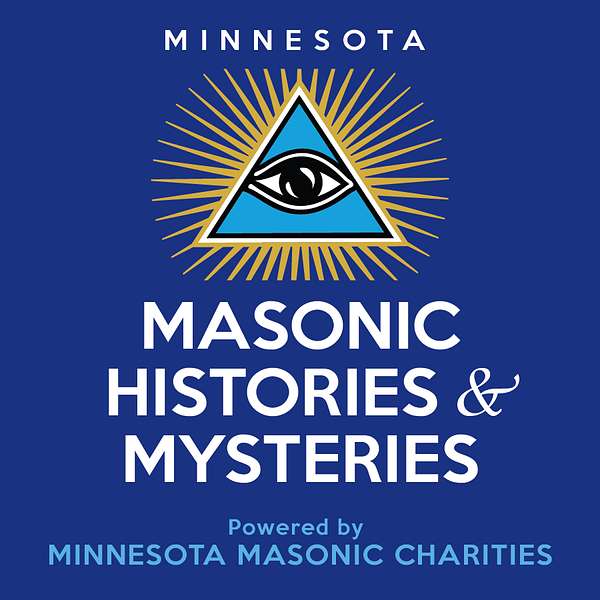
Minnesota Masonic Histories and Mysteries
Ancient, Free and Accepted Masons are a bit of a mystery. Countless books and movies only fuel the mystery behind this "ancient craft." But to many people in need, the Masons are no mystery. Whether it's cancer research, children's healthcare, elder services, scholarships, or numerous other philanthropic ventures, Minnesota Freemasons have become synonymous with building community and giving back to the greater good.
Join Reed Endersbe (Grand Lodge of Minnesota) and John Schwietz (CEO, Minnesota Masonic Charities) as they explore the many unique things about Freemasonry in Minnesota.
Minnesota Masonic Histories and Mysteries
Episode 78. 18:53 Working Tools Series: The Patron Saints
Freemasonry isn’t and has never been a religious organization. It has always been open to members of all religions and faiths. However, the world into which it was born, in Enlightenment-era Europe, was a largely Christian one. As a result, many of the symbols of Freemasonry reflect Christian iconography—including the connection to the two Saint Johns in Freemasonry.
Their feast days are closely associated with the summer and winter solstice – underscoring the symbolic duality of the two figures.
Saint John the Baptist and John the Evangelist, are known as the Patron Saints of Freemasonry. But why? According to John L. Cooper, the reasons for this connection go back centuries and remain shrouded in mystery. What we know for certain is that it isn't strange that there would be a patron saint of Freemasonry. During the Middle Ages in England and Scotland, many societies and guilds were dedicated to a particular saint. That figure received special devotion from the members of the society, and in turn, he would offer its members special protection and favor, In the calendar of the medieval church, there were two Saints named John who were associated with Jesus. One was the forerunner of Jesus, John the Baptist. The other was the Apostle John, the brother of James. He is commonly known as John the Evangelist because of his supposed authorship of the Gospel of John in the New Testament. At some point, these two saints became known as the Patron Saints of Freemasonry. When and where that happened remains a mystery. Now, Freemasonry is not and has never been a religious organization. It has always been open to members of all religions and faiths. However, the world into which it was born in enlightenment era, Europe was a largely Christian one. As a result, many of the symbols of Freemasonry reflect Christian iconography, including the connection to the two St. John's in Freemasonry From the Masonic perspective, we can understand the balanced dualism of John the Baptist on one side, and John, the evangelist on the other. Together they represent two sides of a coin, the passionate zeal of the Baptist and the knowledge of faith of the apostle. A Masonic Lodge dedicated to the two patron saints of Freemasonry can be seen as a space to both reflect on and channel our passion taken as an abstract compilation of symbols. They represent a well-balanced path toward enlightenment. Even more. Their feast days are closely associated with the summer and winter solstice underscoring the symbolic duality of the two figures. But why are St. John the Evangelist and St. John the Baptist, associated with Freemasonry in the first place? How did they become the patron Saints of Freemasonry? Masonic Scholars claim that the custom came from the practice of New Masons taking their obligation on a Bible open to the first chapter of the Gospel of John. The John, who was the supposed author of that gospel was, of course John the evangelist. The opening words of the Gospel of John are quote, in the beginning was the word. And the word was with God, and the word was God unquote. We know that in the 17th and 18th century, the quote Mason word, unquote. Was a very important secret given to the newly obligated mason. The Mason word gave members of the fraternity access to all the privileges of free masonry for operative stone masons that included access to work. The Gospel of St. John May have been chosen for the obligation because of the symbolic connection between the Mason word and the word in the opening verse of the gospel. This connection was so important. Masons in that era were sometimes referred to as quote St. John's Masons unquote, In some Tyler's registers from the 18th century, visitors would put St. John's Mason after their name. From that, we can extrapolate that the connection to the Holy Saints John in the Masonic ritual originated with Saint John the evangelist, and we can assume that the reference to Saint John the Baptist as the second patron saint to Freemasonry came later. none of this can be proven. Of course. These St. John's Masons did not leave us any records about why they adopted that name or why they adopted the two Johns as the Patron Saints of Freemasonry. but author John L. Cooper thinks this is as good a guess as any. This has been another edition of the 1853 Working Tool series. Thanks for listening to Minnesota Masonic Histories and Mysteries.